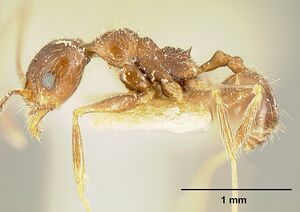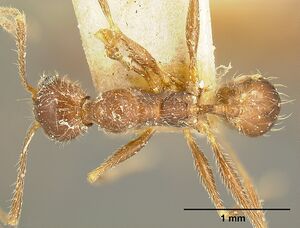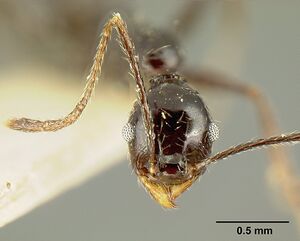Pheidole susannae
| Pheidole susannae | |
|---|---|

| |
| Scientific classification | |
| Kingdom: | Animalia |
| Phylum: | Arthropoda |
| Class: | Insecta |
| Order: | Hymenoptera |
| Family: | Formicidae |
| Subfamily: | Myrmicinae |
| Tribe: | Attini |
| Genus: | Pheidole |
| Species: | P. susannae |
| Binomial name | |
| Pheidole susannae Forel, 1886 | |
| Synonyms | |
| |
Pheidole susannae is a relatively common species in disturbed habitats throughout the Neotropics but occurs in numerous habitat types, including: highly disturbed areas such as city parks, seasonal dry forest, mature lowland rainforest, and second growth rainforest. It can occur on the ground or in the canopy. Workers readily recruit to baits, and major workers often recruit along with minor workers. Nests are in small cavities and appear to be somewhat opportunistically inhabited. (Longino 2009)
Identification
See the description in the nomenclature section.
Keys including this Species
Distribution
Longino (2009) - Southern Mexico to southern Brazil.
Wilson (2003) - Ranging from Veracruz, Mexico, south to Colombia, Venezuela, and Trinidad. I have also verified a record from Cayo Congo, Puerto Rico, col. J. A. Torres. Kempf (1972b) cites the species from Rio Grande do Sul, a doubtful record I have not been able to check.
Latitudinal Distribution Pattern
Latitudinal Range: 21.678819° to -30.0333°.
| North Temperate |
North Subtropical |
Tropical | South Subtropical |
South Temperate |
- Source: AntMaps
Distribution based on Regional Taxon Lists
Neotropical Region: Argentina, Barbados, Brazil, Colombia, Costa Rica, Dominican Republic, El Salvador, Guatemala (type locality), Honduras, Mexico, Netherlands Antilles, Nicaragua, Paraguay, Puerto Rico, Trinidad and Tobago, Venezuela.
Distribution based on AntMaps
Distribution based on AntWeb specimens
Check data from AntWeb
Countries Occupied
| Number of countries occupied by this species based on AntWiki Regional Taxon Lists. In general, fewer countries occupied indicates a narrower range, while more countries indicates a more widespread species. |

|
Estimated Abundance
| Relative abundance based on number of AntMaps records per species (this species within the purple bar). Fewer records (to the left) indicates a less abundant/encountered species while more records (to the right) indicates more abundant/encountered species. |

|
Biology
This widespread species is also very adaptable in habitat and nest site. In Colombia colonies have been found variously in forests and pastures. In Costa Rica, Longino (1997) reports susannae nesting under the bark and into an abandoned termite nest at the base of a large tree and in cracks in the floor of a housing unit near the La Selva Biological Station forest. I found it nesting behind a concrete curb inside a San José, Costa Rica, city park, foraging during the day. On Barro Colorado Island, Panama, I observed a nuptial flight in progress in tropical evergreen forest at 1600 hrs; males were emerging in the company of minors and majors from a crevice in the trunk of a tree 1–2 m from the ground. (Wilson 2003)
Association with Other Organisms
 Explore: Show all Associate data or Search these data. See also a list of all data tables or learn how data is managed.
Explore: Show all Associate data or Search these data. See also a list of all data tables or learn how data is managed.
Other Ants
- This species is a host for the ant Pheidole kusnezovi (a workerless inquiline).
Nematode
- This species is a host for the nematode Mermithidae (unspecified "Mermix") (a parasite) in Guatemala (Wheeler, 1928; Laciny, 2021).
Castes
Minor Worker
Images from AntWeb
   
| |
| Worker. Specimen code casent0178040. Photographer April Nobile, uploaded by California Academy of Sciences. | Owned by ALWC, Alex L. Wild Collection. |
   
| |
| Paralectotype of Pheidole susannae obscurior. Worker. Specimen code jtlc000015317. Photographer John T. Longino, uploaded by California Academy of Sciences. | Owned by MHNG. |
   
| |
| Syntype of Pheidole susannae. Worker. Specimen code jtlc000015335. Photographer John T. Longino, uploaded by California Academy of Sciences. | Owned by MHNG. |
   
| |
| Syntype of Pheidole susannae atricolor. Worker. Specimen code jtlc000015333. Photographer John T. Longino, uploaded by California Academy of Sciences. | Owned by MHNG. |
Major Worker
Images from AntWeb
   
| |
| Lectotype of Pheidole susannae obscurior. Worker (major/soldier). Specimen code jtlc000015316. Photographer John T. Longino, uploaded by California Academy of Sciences. | Owned by MHNG. |
   
| |
| Syntype of Pheidole susannae atricolor. Worker (major/soldier). Specimen code jtlc000015332. Photographer John T. Longino, uploaded by California Academy of Sciences. | Owned by MHNG. |
   
| |
| Syntype of Pheidole susannae. Worker (major/soldier). Specimen code jtlc000015334. Photographer John T. Longino, uploaded by California Academy of Sciences. | Owned by MHNG. |
Nomenclature
The following information is derived from Barry Bolton's Online Catalogue of the Ants of the World.
- susannae. Pheidole susannae Forel, 1886b: xliii (s.w.) GUATEMALA.
- Senior synonym of atricolor: Wilson, 2003: 351.
- atricolor. Pheidole susannae r. atricolor Forel, 1901e: 356 (s.w.q.m.) COLOMBIA.
- Junior synonym of susannae: Wilson, 2003: 351.
Unless otherwise noted the text for the remainder of this section is reported from the publication that includes the original description.
Description
From Wilson (2003): A member of the fallax group, most similar to Pheidole haskinsorum, Pheidole lattkei and Pheidole nubicola, and distinguished as follows.
Major: in both side and frontal views, head tapered conspicuously toward occiput; occipital cleft deep, antennal scape failing to reach the occipital corner by about 2X the maximum scape width; pilosity fringing side and frontal profiles posterior to eye level subrecumbent; rugoreticulum extensive all around the eye; anterior half of first gastral tergite shagreened and opaque; humerus in dorsal-oblique view low and smoothly rounded.
Minor: pronotum entirely smooth; occiput moderately narrowed, with nuchal crest; propodeal spines reduced to denticles.
A highly variable species that may in time prove to be a complex of sibling species.
MEASUREMENTS (mm) Lectotype major: HW 1.30, HL 1.44, SL 1.06, EL 0.20, PW 0.60. Paralectotype minor: HW 0.54, HL 0.82, SL 1.12, EL 0.14, PW 0.40.
COLOR Major: body reddish yellow, gaster a slightly contrasting light reddish brown.
Minor: concolorous medium yellow. Other series vary from reddish yellow to dark brown.
Figure. Upper: lectotype, major. Lower: paralectotype, minor. Scale bars = 1 mm.
Type Material
GUATEMALA: Retalhuleu, Pacific slope. Museum of Comparative Zoology - as reported in Wilson (2003)
Longino (2009):
Syntype major, minor worker: Guatemala, Retalhuleu (Stoll) Musee d'Histoire Naturelle Genève (examined).
Pheidole susannae r. obscurior Lectotype major worker (here designated, labeled with unique pin code JTLC000015316) and associated paralectotype minor worker: Brazil, Rio de Janeiro (Naegeli) Musee d'Histoire Naturelle Genève (examined).
Pheidole partita Brazil, Rio de Janeiro (Naegeli).
Pheidole susannae r. atricolor Syntype major,minor worker, gyne, male: Colombia, Magdalena, San Antonio (Forel) Musee d'Histoire Naturelle Genève (examined).
Pheidole incisa subsp. evoluta Syntype major, minor worker: Brazil, Rio Grande do Sul, Porto Alegre, 30 Nov 1924 (Buck).
Etymology
Eponymous, no attribution given. (Wilson 2003)
References
- Wilson, E. O. 2003. Pheidole in the New World: A dominant, hyperdiverse ant genus. Harvard University Press, Cambridge, MA. (page 351, fig. major, minor described, Senior synonym of atricolor)
- Albuquerque, E., Prado, L., Andrade-Silva, J., Siqueira, E., Sampaio, K., Alves, D., Brandão, C., Andrade, P., Feitosa, R., Koch, E., Delabie, J., Fernandes, I., Baccaro, F., Souza, J., Almeida, R., Silva, R. 2021. Ants of the State of Pará, Brazil: a historical and comprehensive dataset of a key biodiversity hotspot in the Amazon Basin. Zootaxa 5001, 1–83 (doi:10.11646/zootaxa.5001.1.1).
- Casadei-Ferreira, A., Economo, E.P., Feitosa, R.M. 2020. Additions to the taxonomy of Pheidole (Hymenoptera: Formicidae) from the southern grasslands of Brazil. Revista Brasileira de Entomologia 64(4):e20200068 (doi:10.1590/1806-9665-RBENT-2020-0068).
- Dekoninck, W., Wauters, N., Delsinne, T. 2019. Capitulo 35. Hormigas invasoras en Colombia. Hormigas de Colombia.
- Forel, A. 1886b. Espèces nouvelles de fourmis américaines. Ann. Soc. Entomol. Belg. 30:xxxviii-xlix. (page xliii, soldier, worker described)
- Franco, W., Ladino, N., Delabie, J.H.C., Dejean, A., Orivel, J., Fichaux, M., Groc, S., Leponce, M., Feitosa, R.M. 2019. First checklist of the ants (Hymenoptera: Formicidae) of French Guiana. Zootaxa 4674, 509–543 (doi:10.11646/zootaxa.4674.5.2).
- Kempf, W. W. 1964e. Miscellaneous studies on Neotropical ants. III. (Hymenoptera: Formicidae). Stud. Entomol. 7: 45-71 (page 63, senior synonym of evoluta)
- Kempf, W. W. 1972b. Catálogo abreviado das formigas da região Neotropical. Stud. Entomol. 15: 3–344.
- Lubertazzi, D. 2019. The ants of Hispaniola. Bulletin of the Museum of Comparative Zoology, 162(2), 59-210 (doi:10.3099/mcz-43.1).
- Longino, J.T. 2009. Additions to the taxonomy of New World Pheidole. Zootaxa 2181: 1-90. PDF
- Vázquez-Franco, C.M., Morrone, J.J. 2022. The genus Pheidole (Hymenoptera: Formicidae: Myrmicinae) in Puebla, Mexico. Revista Mexicana de Biodiversidad 93: e933820 (doi:10.22201/ib.20078706e.2022.93.3820).
- Wetterer, J.K. 2021. Ants (Hymenoptera, Formicidae) of St. Vincent, West Indies. Sociobiology 68, e6725 (doi:10.13102/sociobiology.v68i2.6725).
- Wheeler, W.M. 1928. Mermis parasitism and intercastes among ants. Journal of Experimental Zoology 50: 165-237 (doi:10.1002/jez.1400500202).
References based on Global Ant Biodiversity Informatics
- Adams B. J., S. A. Schnitzer, and S. P. Yanoviak. 2016. Trees as islands: canopy ant species richness increases with the size of liana-free trees in a Neotropical forest. Ecography doi: 10.1111/ecog.02608
- Adams B. J., S. A. Schnitzer, and S. P. Yanoviak. 2019. Connectivity explains local ant community structure in a Neotropical forest canopy: a large-scale experimental approach. Ecology 100(6): e02673.
- Boer P. 2019. Ants of Curacao, species list. Accessed on January 22 2019 at http://www.nlmieren.nl/websitepages/SPECIES%20LIST%20CURACAO.html
- Boer P. 2019. Ants of Saba, species list. Accessed on January 22 2019 at http://www.nlmieren.nl/websitepages/SPECIES%20LIST%20SABA.html
- Castano-Meneses, G., M. Vasquez-Bolanos, J. L. Navarrete-Heredia, G. A. Quiroz-Rocha, and I. Alcala-Martinez. 2015. Avances de Formicidae de Mexico. Universidad Nacional Autonoma de Mexico.
- Chacon de Ulloa P., A. M. Osorio-Garica, R. Achury, and C. Bermudez-Rivas. 2012. Hormigas (Hymenoptera: Formicidae) del Bosque seco tropical (Bs-T) de la cuenca alta del rio Cauca, Colombia. Biota Colombiana 13(2): 165-181.
- Dattilo W. et al. 2019. MEXICO ANTS: incidence and abundance along the Nearctic-Neotropical interface. Ecology https://doi.org/10.1002/ecy.2944
- De la Mora, A., J. A. Garcia-Ballinas, and S. M. Philpott. 2015. Local, landscape, and diversity drivers of predation services provided by ants in a coffee landscape in Chiapas, Mexico. Agriculture, Ecosystems & Environment 201: 83-91.
- Emery C. 1890. Studii sulle formiche della fauna neotropica. Bull. Soc. Entomol. Ital. 22: 38-8
- Emery C. 1894. Estudios sobre las hormigas de Costa Rica. Anales del Museo Nacional de Costa Rica 1888-1889: 45-64.
- Franco W., N. Ladino, J. H. C. Delabie, A. Dejean, J. Orivel, M. Fichaux, S. Groc, M. Leponce, and R. M. Feitosa. 2019. First checklist of the ants (Hymenoptera: Formicidae) of French Guiana. Zootaxa 4674(5): 509-543.
- INBio Collection (via Gbif)
- Kaspari, M. and M.D. Weiser. Ant Activity along Moisture Gradients in a Neotropical Forest Ant Activity along Moisture Gradients in a Neotropical Forest. Biotropica, Vol. 32, No. 4a (Dec., 2000), pp. 703-711
- Kempf W. W. 1978. A preliminary zoogeographical analysis of a regional ant fauna in Latin America. 114. Studia Entomologica 20: 43-62.
- Kempf, W.W. 1972. Catalago abreviado das formigas da regiao Neotropical (Hym. Formicidae) Studia Entomologica 15(1-4).
- Kusnezov N. 1952. El género Pheidole en la Argentina (Hymenoptera, Formicidae). Acta Zoologica Lilloana 12: 5-88.
- Kusnezov N. 1978. Hormigas argentinas: clave para su identificación. Miscelánea. Instituto Miguel Lillo 61:1-147 + 28 pl.
- Leponce M., J. H. C. Delabie, J. Orivel, J. Jacquemin, M. Calvo Martin, and A. Dejean. 2019. Tree-dwelling ant survey (Hymenoptera, Formicidae) in Mitaraka, French Guiana, in Touroult J. (ed.), “Our Planet Reviewed” 2015 large-scale biotic survey in Mitaraka, French Guiana. Zoosystema 41 (10): 163-179.
- Longino J. T. 2009. Additions to the taxonomy of New World Pheidole (Hymenoptera: Formicidae). Zootaxa 2181: 1-90.
- Longino J. T. L., and M. G. Branstetter. 2018. The truncated bell: an enigmatic but pervasive elevational diversity pattern in Middle American ants. Ecography 41: 1-12.
- Longino J. et al. ADMAC project. Accessed on March 24th 2017 at https://sites.google.com/site/admacsite/
- Maes, J.-M. and W.P. MacKay. 1993. Catalogo de las hormigas (Hymenoptera: Formicidae) de Nicaragua. Revista Nicaraguense de Entomologia 23.
- Miguelena Bada J. G. 2008. Estructura y composición de las comunidades de hormigas en ambientes contrastantes en el parque estatal Flor del Bosque en Amozoc de Mota, Puebla. Tesis Licenciatura. Biología. Departamento de Ciencias Químico-Biológicas, Escuela de Ingeniería y Ciencias, Universidad de las Américas Puebla. Mayo.
- Mirmecofauna de la reserva ecologica de San Felipe Bacalar
- Ottonetti L., L. Tucci, F. Frizzi, G. Chelazzi, and G. Santini. 2010. Changes in ground-foraging ant assemblages along a disturbance gradient in a tropical agricultural landscape. Ethology Ecology & Evolution 22: 7386.
- Pires de Prado L., R. M. Feitosa, S. Pinzon Triana, J. A. Munoz Gutierrez, G. X. Rousseau, R. Alves Silva, G. M. Siqueira, C. L. Caldas dos Santos, F. Veras Silva, T. Sanches Ranzani da Silva, A. Casadei-Ferreira, R. Rosa da Silva, and J. Andrade-Silva. 2019. An overview of the ant fauna (Hymenoptera: Formicidae) of the state of Maranhao, Brazil. Pap. Avulsos Zool. 59: e20195938.
- Santschi F. 1925. Fourmis des provinces argentines de Santa Fe, Catamarca, Santa Cruz, Córdoba et Los Andes. Comunicaciones del Museo Nacional de Historia Natural "Bernardino Rivadavia" 2: 149-168.
- Smith M. A., W. Hallwachs, D. H. Janzen. 2014. Diversity and phylogenetic community structure of ants along a Costa Rican elevational gradient. Ecography 37(8): 720-731.
- Snelling R. 1993. Ants of Guana Island, British Virgin Islands. Notes From Underground 8: 11-12.
- Torres, Juan A. and Roy R. Snelling. 1997. Biogeography of Puerto Rican ants: a non-equilibrium case?. Biodiversity and Conservation 6:1103-1121.
- Wetterer J. K., M. J. Liles, J. M. Sermeno, L. Serrano Cervantes, E. E. Echeverria, R. M. Estrada Hernandez, A. Henriquez, D. Perez, D. A. Sanchez Garcia, C. E. Gomez Peralta, R. Lopez Sorto, and G. Melendez. 2016. Predaceous fie ants (Hymenoptera: Formicidae) at sea turtle (Testudines: Cheloniidae) nestig beaches and hatcheries in El Salvador. Florida Entomologist 99(1): 106-109.
- Wheeler W. M. 1905. The ants of the Bahamas, with a list of the known West Indian species. Bulletin of the American Museum of Natural History 21: 79-135.
- Wheeler W. M. 1922. The ants of Trinidad. American Museum Novitates 45: 1-16.
- Wheeler W. M. 1928. Mermis parasitism and intercastes among ants. Journal of Experimental Biology 50: 165-237.
- Wild, A. L. "A catalogue of the ants of Paraguay (Hymenoptera: Formicidae)." Zootaxa 1622 (2007): 1-55.
- Wilson, E.O. 2003. Pheidole in the New World: A Dominant, Hyperdiverse Genus. Harvard University Press



